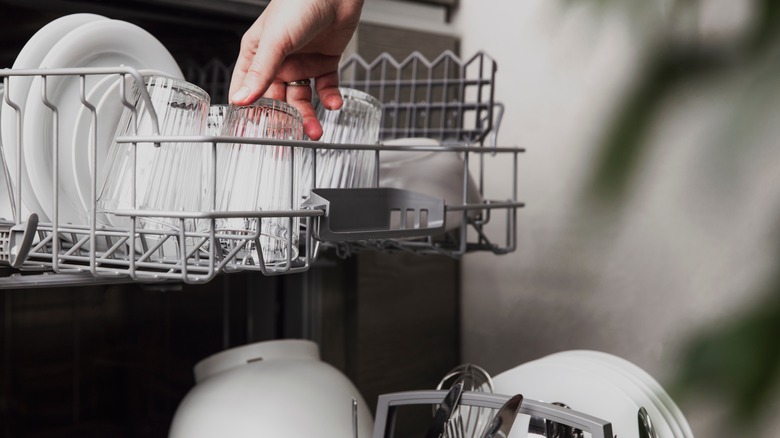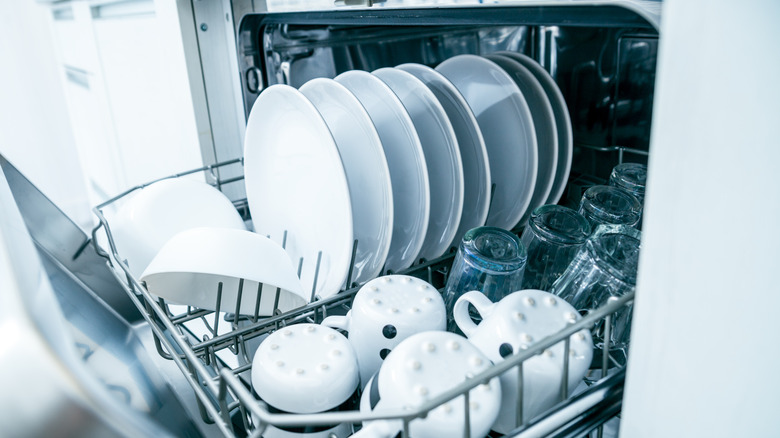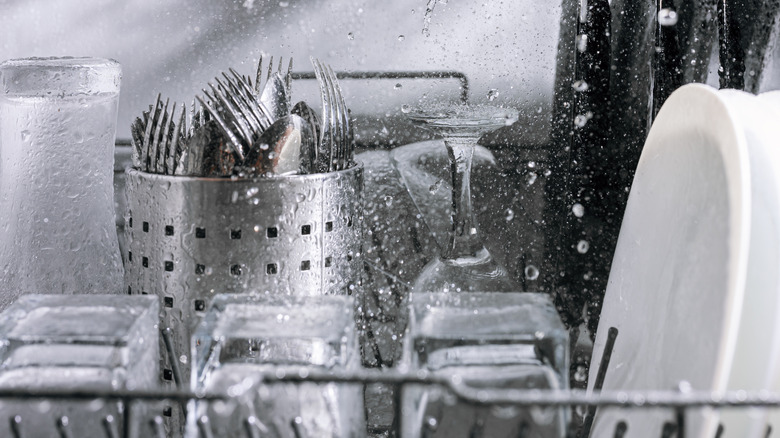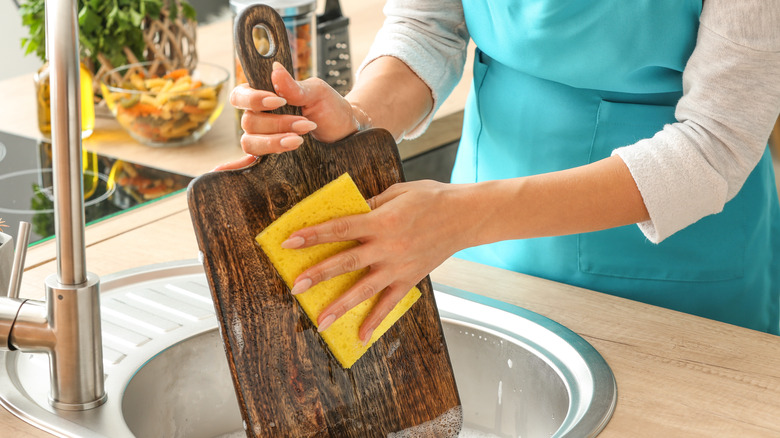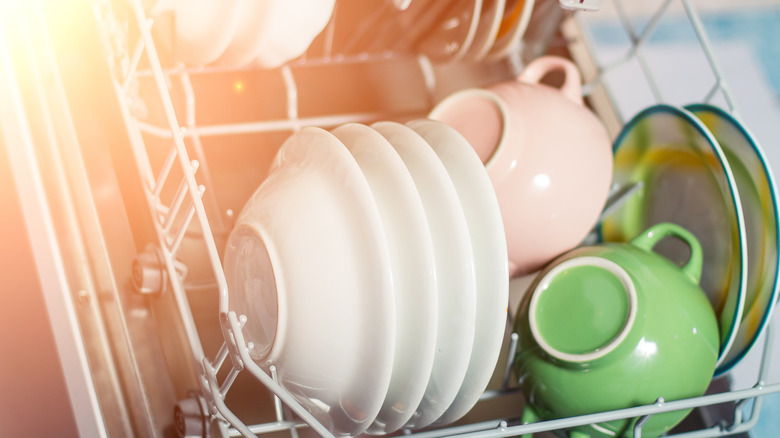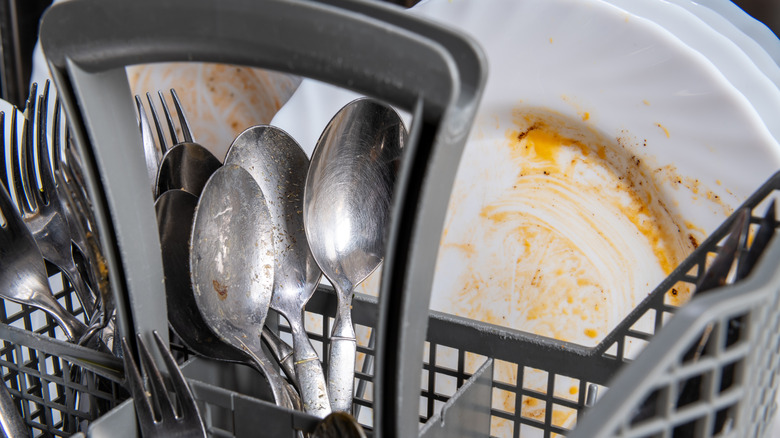5 Tips For Loading Your Dishwasher So Every Dish Gets Squeaky Clean
If you're extra busy or just hate bending over the sink, you probably rely heavily on your dishwasher. Dishwashers are typically one of the most used appliances in the kitchen. The Cleaning Institute says that using the dishwasher could save you time. It could also save you effort, as placing dishes in this appliance could save you from scrubbing. The dishwasher will also keep your sink and counters clutter-free, and it will make cleaning up after a party much easier. It could also help you keep your dishes safer, as most dishes are broken when being cleaned by hand.
Loading the dishwasher can seem like a no-brainer. However, there's actually a certain way to load this appliance for the cleanest dishes. Loading the correct way will also save energy and water. There are five important tips to understand in order to load the dishwasher the correct way. When following these tips, you should have squeaky clean dishes every time.
Place items in the right places
When loading the dishwasher, it's important to know where certain items should be placed. Consumer Reports says that the top rack can hold cups, small bowls, and dishwasher-safe plastics. Whirlpool adds that wine glasses, water bottles, and mugs can also be placed on the top rack. Long utensils should be laid flat. Plates, serving dishware, larger bowls, pots, pans, and oversized pieces can all be placed on the bottom rack. This is also typically where the silverware basket is located. Oversized items should be placed on the sides or at the back of the rack so they don't obstruct the cleaning of other dishes.
There is also a certain way to position dishes so they get as clean as possible. If a dish has baked-on food, it should be placed face down on the bottom rack. Cups can be placed with the opening face down as well. Bowls and plates can be placed on their side, but the dirty side should be angled toward the bottom of the dishwasher.
Be intentional with silverware
When loading silverware in the dishwasher, the most important thing is to make sure there's no overcrowding. This could cause some of the pieces to not get thoroughly cleaned. GE Appliances says to distribute silverware evenly throughout the basket. For safety, forks and knives should be placed with the handle facing up. Spoons can either be placed face down or up — if there are lots of pieces crowding the spoons, place them with the handles down.
To ensure the best clean, make sure that long silverware isn't falling through the bottom of the basket. This could obstruct the washer jets beneath the bottom rack. Also ensure that the items around the basket aren't obstructing the jets, per Cascade Clean. Small plastic items are best placed on the top rack and not with the silverware because the top rack is less hot and will prevent melting. Large serving utensils should also be placed on the top rack and not in the silverware basket.
Wash some items by hand
Some items should not be placed in the dishwasher but should always be washed by hand. Serious Eats says that sharp items like knives or blades should be washed by hand, as they could be dulled in the dishwasher. Cast iron, non-stick, copper, and carbon steel pots and pans should also stay out. It's best to only put stainless steel items in the dishwasher. Fragile pieces like fine china, fancy dishware, or crystal items could be damaged as well. Wooden pieces like cutting boards and serving utensils could crack or be warped by excess water. Marble and granite items also risk being damaged.
Whirlpool says that thinner plastic items could melt in the dishwasher, so they should only be washed by hand. However, thicker plastics or those labeled as dishwasher safe can be placed on the top rack. Silver items could rust and should never go in the dishwasher. Insulated mugs and containers could also be damaged.
Make sure every dish is cleaned
There are two big no-no's when loading the dishwasher that you'll want to make sure you avoid. The first is placing a large item like a pan, platter, or cutting board in front of the dishwasher door, per Whirlpool. This could block the detergent from reaching the other items, leading to a dirty load. Appliance Answers also warns against overcrowding the dishwasher. Washer jets are located underneath the bottom rack on rotating arms. Stacking dishes or placing them too close to one another could keep them from getting thoroughly cleaned.
If your dishes still aren't coming out clean, you may need to clean the spray arms. Mr. Appliance says that these can be removed and cleaned with a soft brush and a small amount of dish soap. You could also be using too much or too little detergent. Or, the inside of your appliance may be dirty. To clean it, run a rinse cycle with 3 cups of vinegar in the bottom of the machine.
You don't have to pre-rinse
While some people swear by pre-rinsing their dishes, this is unnecessary for modern models. In fact, cleaning your dishes before placing them in the dishwasher can actually cause them to be more dirty, per Home Serve. Some pre-rinse because they fear that the dishwasher isn't powerful enough or that the jets will get clogged by food particles. However, neither of these situations are likely. Newer models actually have a soil sensing system. This means that the dirtier the dishes are, the cleaner they will be. Also, detergents clean by clinging to food particles — if you put clean dishes in, the detergent won't have anything to cling to. And, pre-rinsing also wastes water.
Whirlpool points out that you can adjust the dishwasher's settings to choose one that's right for your dishes' level of dirtiness. However, if you have an older appliance, you may want to pre-rinse, as it probably doesn't have a soil sensing system.
